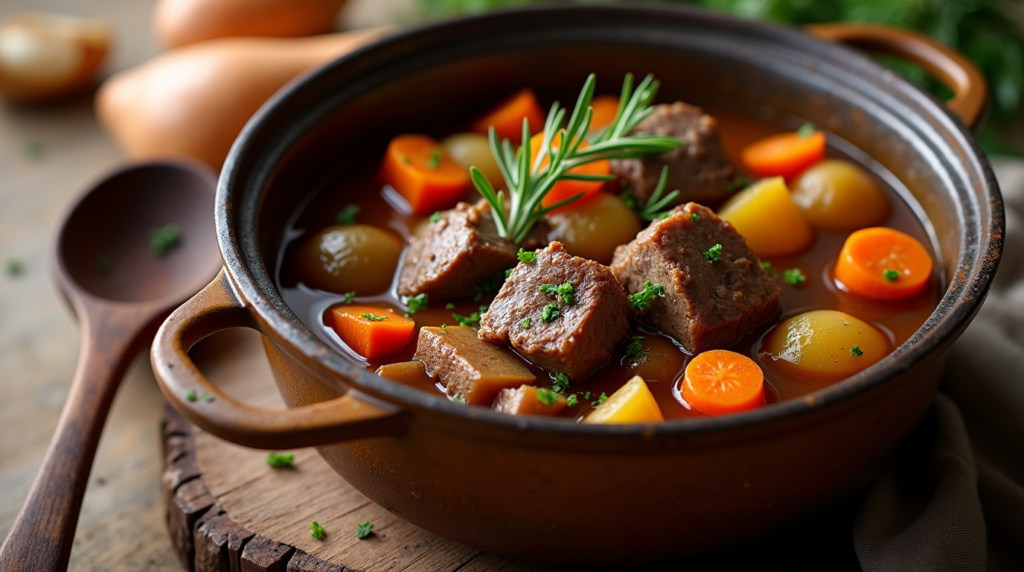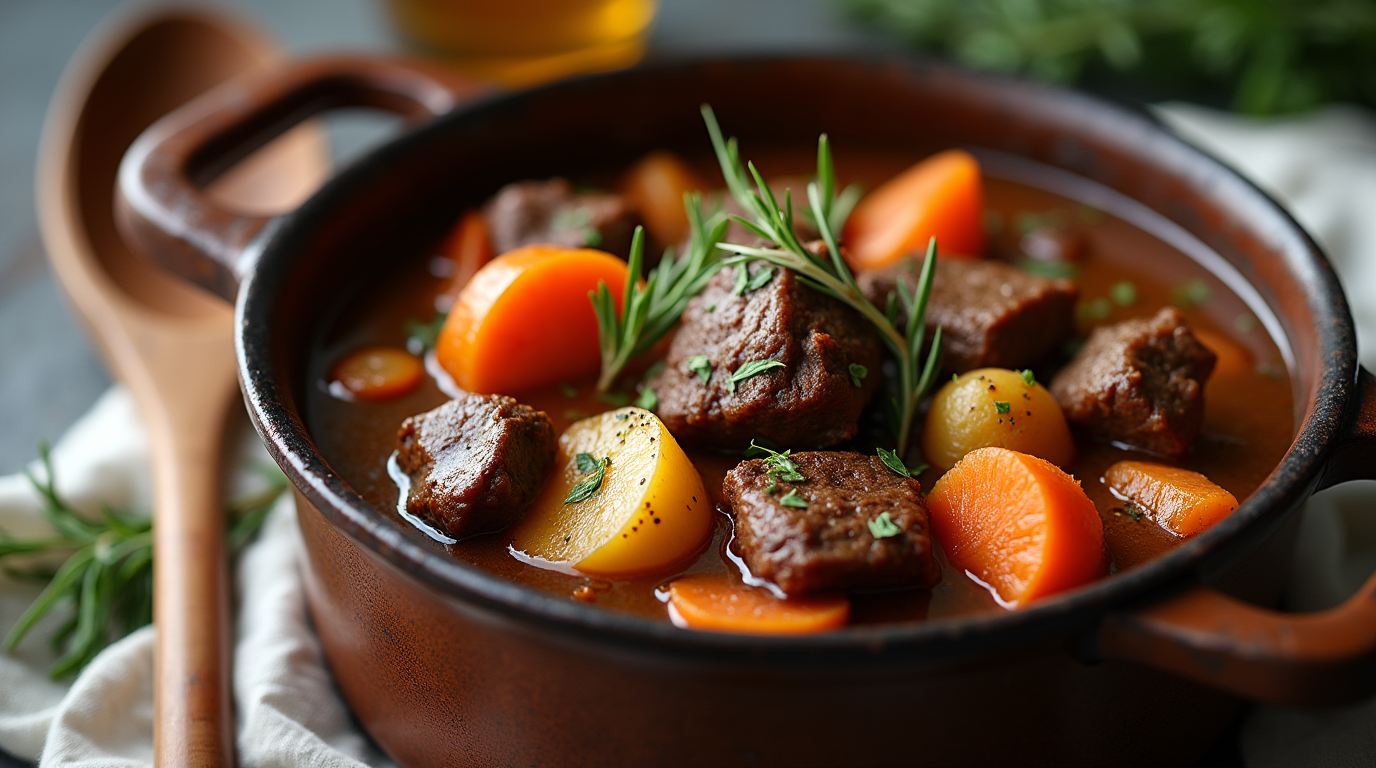Slow-Cooked Lamb Stew: A Hearty Feast with Minimal Effort
Imagine walking through the door after a long day, the rich scent of a slow-cooked lamb stew wafting through the air. It’s the kind of aroma that invites you in, makes you feel at home, and promises a meal that will comfort both your stomach and soul. Whether it’s a special family gathering or a cozy night in, slow-cooked lamb stew has a way of bringing people together. This dish isn’t just a meal; it’s a moment — a tradition that can be passed down for generations.
Why Slow-Cooked Lamb Stew is a Must-Try Recipe
If you’ve never tried slow-cooked lamb stew before, you’re in for a treat. Slow cooking allows the lamb to become incredibly tender while absorbing all the flavors from the herbs, spices, and vegetables. Unlike quick cooking methods, slow cooking allows the stew’s flavors to meld and develop depth, resulting in a dish that’s not only flavorful but also nourishing.
The Magic of Slow Cooking
Slow cooking might take time, but it’s worth every minute. Here’s why:
- Tender Meat: The slow process breaks down the tough fibers in the lamb, making it melt-in-your-mouth tender.
- Flavor Infusion: Cooking the ingredients for hours allows the lamb, vegetables, and broth to fully absorb each other’s flavors, resulting in a rich and hearty stew.
- Nutrient Retention: Unlike high-heat methods, slow cooking retains more of the essential vitamins and nutrients in the ingredients.
The Health Benefits of Lamb
Lamb is a nutrient-dense meat that offers numerous health benefits. When used in a stew, you get a perfect combination of flavor and nourishment. Here’s why you should consider adding it to your meals:
- Rich in Protein: Lamb is an excellent source of high-quality protein, essential for muscle repair and growth.
- Packed with Vitamins: It’s an excellent source of Vitamin B12, which helps maintain healthy nerve function.
- High in Iron: Lamb provides iron, which is vital for healthy blood and energy levels.
- Omega-3 Fatty Acids: Lamb is also a great source of healthy fats, which support heart health.
How to Make Slow-Cooked Lamb Stew

Now that you know why this stew is so amazing, let’s talk about how to make it. The recipe is simple, but the results are extraordinary. Here’s everything you need:
Ingredients
For a comforting and delicious stew, you’ll need these essential ingredients:
Table: Ingredients for Slow-Cooked Lamb Stew
| Ingredient | Amount | Notes |
|---|---|---|
| Lamb (shoulder or shank) | 2 lbs | Cut into chunks |
| Carrots | 2 large | Peeled and sliced |
| Potatoes | 3 medium | Peeled and diced |
| Onion | 1 large | Diced |
| Garlic | 3 cloves | Minced |
| Beef or chicken broth | 4 cups | Low sodium preferred |
| Fresh thyme | 2 sprigs | Optional for garnish |
| Fresh rosemary | 1 sprig | Optional for garnish |
Step-by-Step Instructions
Making lamb stew is a simple process, but the magic happens over time. Follow these steps:
Prepare the Lamb:
- Begin by browning the lamb in a hot pan. This caramelizes the meat, adding depth and flavor to the stew.
Sauté Vegetables:
- In the same pan, sauté the diced onion and garlic until softened and fragrant. Add the carrots and potatoes, allowing them to pick up some of the flavors from the meat and garlic.
Combine Everything in the Slow Cooker:
- Transfer the lamb and vegetables to your slow cooker. Pour in the broth and add the sprigs of fresh thyme and rosemary. These herbs will infuse the stew with aroma and flavor.
Slow Cook:
- Set your slow cooker to low and let it cook for 6-8 hours. If you’re short on time, you can set it to high for 3-4 hours, but the low setting will yield the most tender and flavorful results.
Pro Tips for Perfecting Your Slow-Cooked Lamb Stew
- Layer Your Flavors: Slow cooking isn’t a race. Allow time for the flavors to meld together. The longer you cook, the richer the flavor.
- Use Root Vegetables: Carrots, parsnips, and potatoes do wonders in stews. They not only add substance but also absorb the deep flavors of the lamb and herbs.
- Seasoning Matters: Season your stew at the beginning, but don’t forget to adjust toward the end. Fresh herbs and a pinch of salt can make a big difference.
- Add Some Extra Protein: If you want to bulk up your stew, consider adding beans or lentils for an added layer of texture and nutrition.
How to Serve Slow-Cooked Lamb Stew
Lamb stew is hearty enough to be a meal on its own, but pairing it with the right sides can elevate the entire experience.
Classic Side Dishes to Pair With:
- Warm, Crusty Bread: Freshly baked bread is perfect for soaking up the rich, savory broth.
- A Light Salad: Pair your stew with a tangy salad to balance the richness. A simple vinaigrette will do the trick.
- Mashed Potatoes or Rice: Serve your stew over a bed of mashed potatoes or rice for a comforting, filling meal.
Serving Suggestions:
- Garnish with Fresh Herbs: Rosemary or thyme makes a beautiful garnish and adds a final touch of freshness.
- Top with Cream: For an extra indulgent stew, add a dollop of sour cream or crème fraîche on top just before serving.
Variations and Customizations for Your Slow-Cooked Lamb Stew
This recipe is versatile and can easily be customized based on your tastes or what you have on hand. Here are some creative ways to change it up:
- Spice It Up:
- Add chili flakes or cumin for a kick of heat. You can also try adding curry spices for a Moroccan-inspired version of lamb stew.
- Add Wine for Depth:
- A splash of red wine will add complexity and depth to the broth, making it even richer.
- Try Different Vegetables:
- Experiment with butternut squash, turnips, or parsnips. These vegetables will bring their own unique flavor while enhancing the stew’s heartiness.
The Best Cuts of Lamb for Stew
When choosing lamb for stew, not all cuts are created equal. Some cuts are better suited for slow cooking, ensuring the stew comes out tender and flavorful.
Shoulder:
- The shoulder is the most popular cut for lamb stew. It’s flavorful, well-marbled, and perfect for slow cooking. It yields tender meat after hours of cooking.
Shank:
- Though a bit tougher, lamb shank becomes incredibly tender and flavorful when cooked slowly. It’s an ideal cut for those who enjoy rich, meaty stews.
Rump or Leg:
- While leaner, these cuts can work well in a stew, especially if you cook them slowly to break down the fibers and enhance their tenderness.
Frequently Asked Questions (FAQ) About Slow-Cooked Lamb Stew
Can I use lamb stew meat instead of shoulder or shank?
Yes, lamb stew meat is often pre-cut into bite-sized pieces, making it convenient. However, cuts like shoulder or shank will provide more flavor and tenderness, especially when slow-cooked.
How can I make my stew thicker?
If you find your stew too thin, you can thicken it by mashing some of the potatoes or adding a cornstarch slurry (cornstarch mixed with water) during the last hour of cooking.
Can I make slow-cooked lamb stew in a pressure cooker?
Absolutely! If you’re short on time, a pressure cooker can cut the cooking time down significantly. Cook the stew for 35-40 minutes at high pressure for tender meat and flavorful broth.
Can I freeze leftover lamb stew?
Yes, lamb stew freezes wonderfully! Store leftovers in an airtight container for up to 3 months. Just be sure to cool the stew completely before freezing it.
Conclusion: Why You Should Try Slow-Cooked Lamb Stew Today
Slow-cooked lamb stew is more than just a meal; it’s an experience. The slow cooking process transforms the lamb into a melt-in-your-mouth delight, while the vegetables and broth combine to create a savory, comforting stew that’s perfect for any occasion. So gather your ingredients, set your slow cooker, and enjoy a dish that’s sure to become a favorite in your household. Whether you’re cooking for family or friends, slow-cooked lamb stew is a recipe that’s both simple and special. Give it a try today, and savor the warmth and joy it brings to your table.

